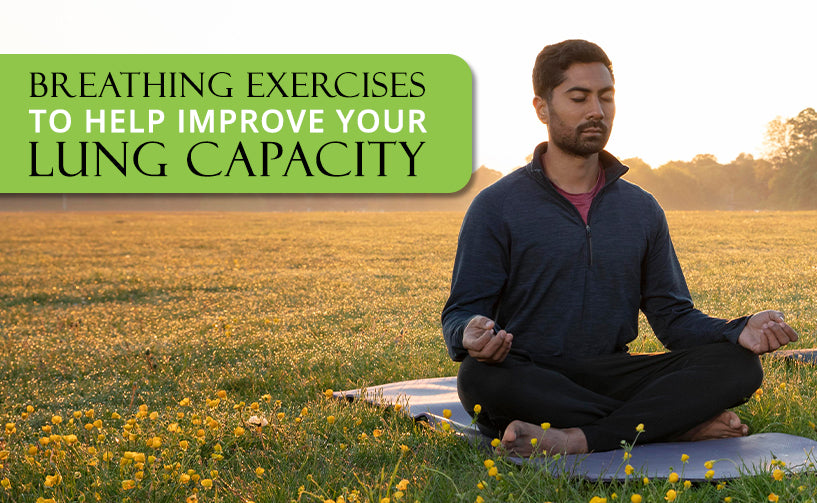By helping deliver oxygen to the bloodstream and simultaneously removing carbon dioxide waste, our lungs play a vital role in the daily functioning of our bodies. It is the lung function and lung capacity that determine how well the lungs deliver oxygen and eliminate carbon dioxide from the bloodstream. The lung function determines how well the body uses the oxygen it receives and the lung capacity, on the other hand, indicates how much air or oxygen the lungs can hold and how quickly air moves in and out of the lungs.
That said, compromised lung health due to chronic lung diseases, such as asthma, pulmonary fibrosis and chronic obstructive pulmonary disease (COPD) can hamper this process. In such cases, the lung is unable to efficiently hold air and supply the required amount of oxygen for the body, causing difficulty in breathing and shortness of breath. In addition to this, factors such as smoking, environmental pollution, age, and other factors can also deteriorate the lungs and decrease their capacity. While a person may not be able to change how much amount of oxygen their lungs can hold, it is possible to improve their lung capacity. This article highlights some of the best breathing exercises specifically designed to help reduce shortness of breath caused by limited lung capacity and function and also to help improve overall lung health, so keep on reading.
Exercise to Improve Lung Capacity
Lung exercises are an excellent way to not only help your lungs become more efficient at managing airflow and oxygen levels but also to enhance overall lung health. It promotes better breathing, reduces shortness of breath, strengthens your lung muscles or diaphragm and helps lower the risks of various respiratory-related complications. Here are some lung exercises that are designed to help improve your lung capacity so that your body can make better use of available oxygen supplies without any troubles.

- Belly Breathing or Diaphragmatic Breathing
The diaphragm is a large, dome-shaped muscle that sits in between the chest and the abdomen. It pulls in air and then forces out the air by contracting and then relaxing as we inhale and exhale. In fact, the diaphragm is the main muscle or the one that does most of the work when it comes to breathing. That said, instead of using our diaphragm muscles to breathe, most of us unknowingly utilizes the muscles in our neck, back and shoulders to breathe, which greatly restricts the amount of air that enters and leaves our lungs. Therefore, breathing using the diaphragm muscles, which is known as belly breathing or diaphragmatic breathing is recommended by experts to help improve lung capacity.
Diaphragmatic breathing not only strengthens the diaphragm muscles but also helps the lungs to function more efficiently. A 2016 study published in the Journal of Physical Therapy Science has also shown the benefits of diaphragmatic breathing when it comes to improving lung capacity among participants practising lung exercise.
What you need to do:
- Sit back or lie down and make sure your neck and shoulders are relaxed.
- Place one hand on your belly and the other one on your chest.
- Deeply inhale through your nose and exhale through your mouth for 2- 3 seconds each.
- As you exhale, press down on your abdomen.
- Make sure you are engaging your diaphragm muscles throughout the process.
- Repeat the process.
- The technique works best when well-rested.
Also Read: 6 Yoga Poses for Better Lung Health
- Pursed Lip Breathing
Pursed lip breathing is a breathing technique designed to improve the flow of air in and out of the lungs. Unlike diaphragmatic breathing, pursed lip breathing is a simple breathing exercise for lung health that can be easily executed by anyone at any time of the day. This lung exercise reduces or slows down your breathing and helps keep your airways open longer, which in turn supports and improves the easy exchange of oxygen and carbon dioxide. Studies have also suggested that pursed lip breathing is especially beneficial for people who are physically inactive and are not utilizing much of their breathing muscles.

What you need to do:
- Make sure you are in a straight, sit-up position.
- Slowly and deeply inhale through your nostrils.
- In a controlled fashion, slowly exhale through your mouth, with pursed lips, as if pouting.
- Make sure that your exhalation is twice as long as your inhalation.
- Repeat the process.
- You can put timings on the inhalation and exhalation if required.
Tips for Maintaining Good Lung Health
Breathing exercises may help improve lung capacity to a certain extent but they cannot reverse or repair lung damage. Hence it is important to take care of your lungs' health while you can so that they remains healthy and efficient in their functioning. Prevention is always better than cure. So here are some helpful tips you can follow to maintain good, functioning lung health.
- Avoid smoking or quit if you are smoking. Also Read: 10 Reasons Why You Should Quit Smoking For Good
- Eat healthy foods rich in antioxidants.
- Drink plenty of water.
- Stay physically active.
- Avoid secondhand smoke or environmental pollutants.
- Eliminate mould or dust at home.
- Get flu vaccines as this can help prevent lung infections and promote lung health.
- Invest in healthy natural supplements to help enhance your lung health and functioning.
Speaking of healthy natural supplements, Preserva Wellness Curcumin-based, Daily Strength Juice and Daily Boost Tea are the ones you need to maintain healthy, functioning lungs! Preserva Daily Strength Juice is a 100% plant-based formula comprising Aloe vera, Tulsi and 95% pure Curcumin extract. It is an excellent natural tonic for the lungs as it is packed with lung-healthy antioxidants and other essential nutrients beneficial for improving lung health and its overall functioning. It works wonders when it comes to relieving common respiratory-related issues such as sore throat, persistent cough, and fever, and is an excellent aid in reducing the risk of asthma, bronchitis and other respiratory disorders. On top of that, the juice also works wonderfully in improving oxygen absorption ability, making it a natural remedy for cigarette smoke-induced lung complications. Also Read: Curcumin and Its Lung Health Benefits
Likewise, Daily Boost Tea is no different. With a rich mix of invigorating ingredients like 95% pure Curcumin extract, Assam Green Tea, Ginger, Liquorice, Cinnamon, Cloves, Cardamom, Long Pepper, Nutmeg and Black Pepper, Daily Boost Tea offers a unique blend that is packed with natural antioxidants and anti-allergic properties that actively work their way to protecting the lungs from harmful substances and strengthening the respiratory system all at the same time! The masala-inspired tea blend is flavourful in taste and effective when it comes to relieving sore throat, coughing and blockage.
The Bottom Line
Although you may not be able to reverse the damage or harm done to your lungs, you can, however, improve its capacity and enhance its overall functioning. Lung exercises such as diaphragmatic breathing or belly breathing and pursed lip breathing are some of the best and most effective ways to help you in that process. Moreover, lung exercises, such as pursed lip breathing are especially helpful for those who are physically inactive as it helps them to utilize their breathing muscles more while improving their overall respiratory health at the same time. That said, people with underlying health issues like COPD need to consult with a doctor before trying any new exercise, including breathing exercises to ensure safe and effective results.
Disclaimer- This article is intended for informational purposes only. It is not a substitute for professional medical advice, diagnosis or treatment. Always consult with your healthcare provider in case of any health complications





